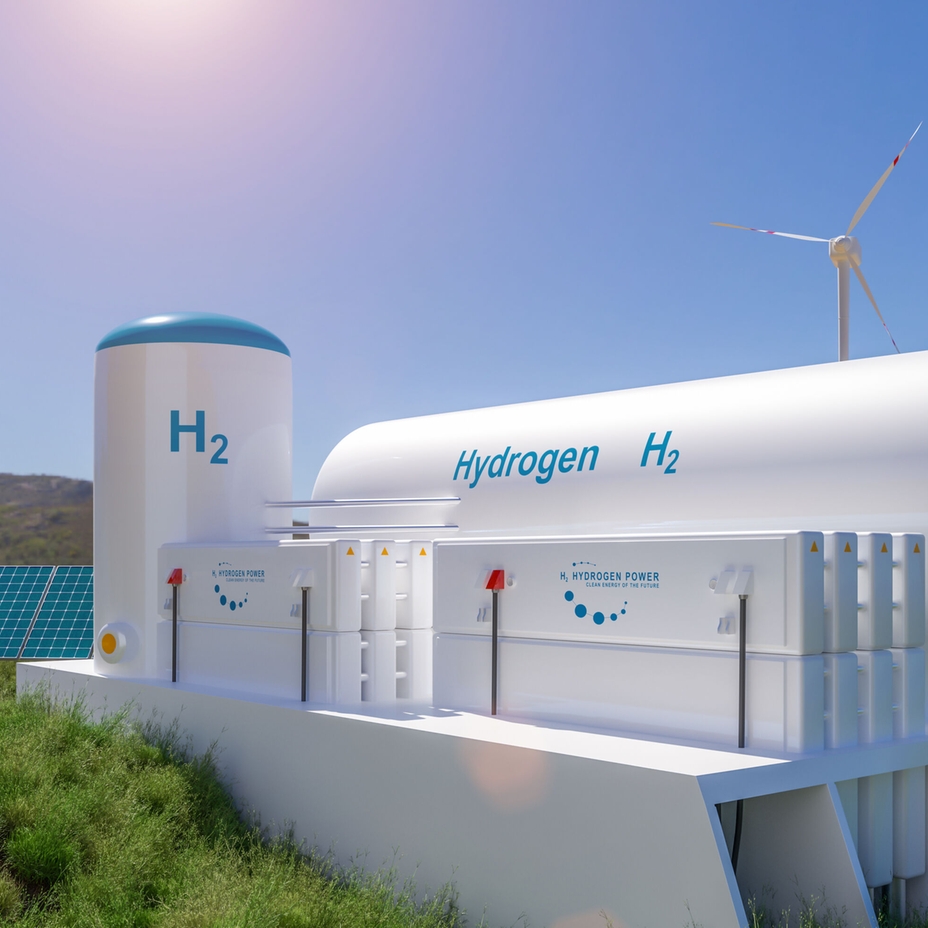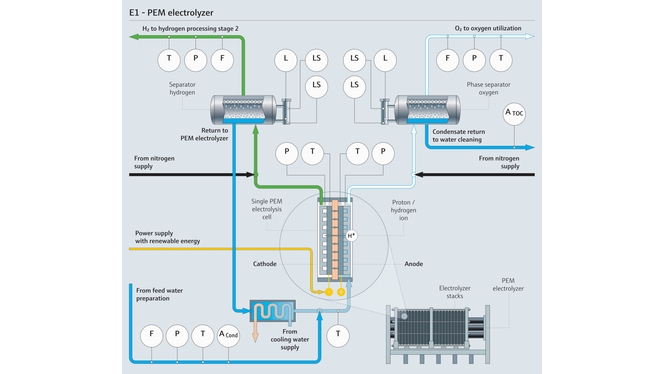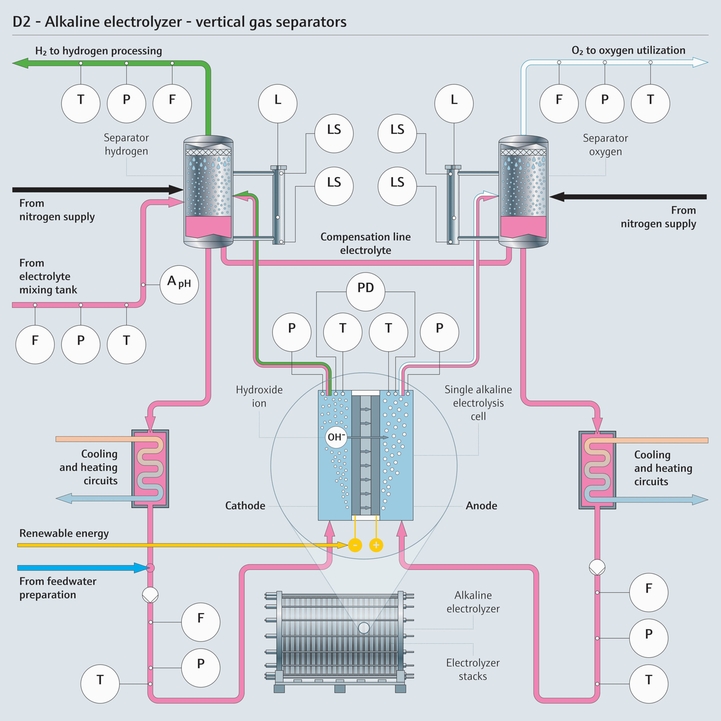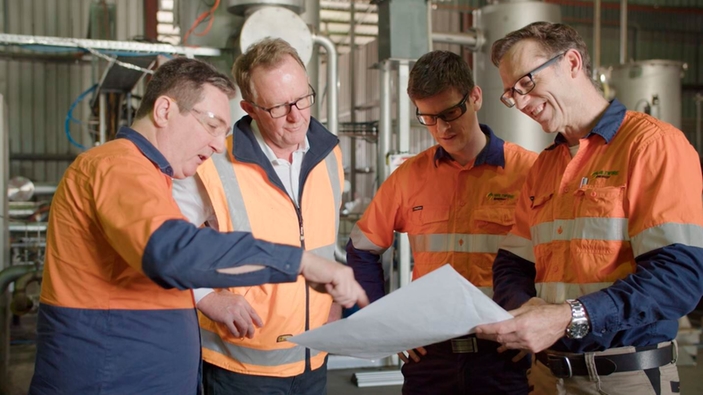Electrolysis, the primary method for producing green hydrogen, is still relatively inefficient. Improving electrolysis efficiency is crucial to reduce the cost of green hydrogen production. Fine-tuning the operational parameters of electrolyzers, such as current density, temperature and operating pressure, can significantly impact energy efficiency. Optimizing these parameters can maximize the output of green hydrogen while minimizing renewable energy consumption and material degradation.
Key facts
70%
of electrical energy is currently converted into hydrogen. (Source: IEA 2021 report)
Hydrogen production process maps

Measuring water quality for efficient electrolysis
The production of green hydrogen involves the electrolysis of water. This process requires a substantial amount of water. A sustainable use of water resources is a valid concern when producing green hydrogen. Pure or distilled water has to be used in electrolysis to minimize the presence of impurities that could interfere with the chemical reaction and reduce the efficiency of the green hydrogen production process. High-purity water is obtained through processes like reverse osmosis.
Our expertise in the field
It is essential to measure the following parameters: level, flow, pressure, conductivity and in some cases pH.
- Conductivity is a key measurement parameter in ensuring the quality of water. Our digital conductivity sensor Memosens CLSE16 has Memosens 2.0 technology with data storage and contactless transmission.
- Flowmeters are used for monitoring conductive liquids and ensure the reliability of the electrolyzer's water feed. The Promag W 10 is the world's first electromagnetic flowmeter for unrestricted installation measurements.
- Measuring pressure during the preparation of water for electrolysis is essential to detect blockages in filtration and osmosis. Our Cerabar PMP51B is a reliable and easy-to-use sensor for reducing systematic faults in green hydrogen production.
- Measuring level is crucial for maintaining a consistent supply, preventing dry running and promoting resource efficiency. Levelflex FMP51 is suitable for hydrogen and oxygen separators and highly resistant to corrosive substances.

Alkaline water electrolysis
Alkaline water electrolysis is a process that involves splitting water into hydrogen and oxygen using an electrolyzer. In this method, an alkaline solution, typically potassium hydroxide, serves as the electrolyte to facilitate the electrochemical reactions. Alkaline water electrolysis is known for its efficiency and simplicity, making it a viable technology for large-scale hydrogen production, especially when powered by renewable energy instead of fossil fuel sources.
Our expertise in the field
To enhance production efficiency and ensure optimal performance, it is essential to measure specific parameters, including flow, level, temperature, and pressure. All these critical parameters are conveniently provided by Endress+Hauser.
- To ensure efficient oxygen production a vortex flowmeter such as Prowirl F 200 is a perfect match.
- If water in the separators gets to high it can overflow in to the electrolyzer's cells. Liquid level detection with vibrating tuning fork with Liquiphant FTL51B prevents this overflow.
- The temperature of the electrolyzer affects the rate of the electrolysis reaction. Our temperature sensor iTHERM Moduline TM131 can be used to optimize the operating parameters of the electrolyzer.
- Conductivity is a key measurement parameter in ensuring the quality of water. Our digital conductivity sensor Memosens CLS16E has Memosens 2.0 technology with data storage and contactless transmission.

PEM water electrolysis
PEM (Proton Exchange Membrane) electrolyzers stand as another widely used technology alongside alkaline electrolyzers. The technology relies on a solid polymer electrolyte membrane, allowing for compact design and precise control, making it particularly well-suited for applications requiring flexibility and responsiveness in green hydrogen production. PEM electrolyzers offer advantages such as high efficiency, rapid response to changing loads, and suitability for decentralized applications.
Our expertise in the field
To achieve optimal production efficiency of hydrogen with renewable resources instead of fossil fuels, the measurement of key parameters remains crucial. Parameters such as flow, level, temperature, and pressure, essential for process optimization, can be effectively monitored using Endress+Hauser instrumentation, ensuring reliable performance in PEM electrolysis systems.
- Coriolis mass flowmeters are highly accurate and reliable in measuring mass flow rates. Promass F 300 can be used to optimize the operating parameters of the PEM electrolyzer.
- Measuring level in separators ensures hydrogen purity. Levelflex FMP51 is suitable for hydrogen and oxygen separators.
- If pressure of the gases becomes uneven, there is a risk of explosion. Our pressure transmitter Cerabar PMP51B is a reliable and easy-to-use sensor for reducing systematic faults.

Safe green hydrogen compression and storage
Hydrogen stands out as the sole energy vector capable of effectively storing excess energy, whether through compression or cavern storage. Liquid Organic Hydrogen Carriers (LOHCs) present an alternative approach for storing and transporting hydrogen. In this method, hydrogen is chemically bonded to a liquid organic compound, allowing for a higher energy density compared to gaseous hydrogen.
Our expertise in the field
As the interest in LOHCs grows for their potential in hydrogen storage, it becomes crucial to monitor and optimize the processes involved. Endress+Hauser's precision sensors provide reliable means to monitor the intricate dynamics of LOHC systems, ensuring efficient and controlled operations throughout the hydrogen storage and release cycles.
- Ensuring accurate pressure measurement is essential to prevent overpressures and extend the lifetime of the compressors. Our pressure transmitter Cerabar PMP71B measures accurately and reliably the hydrogen compression.
- The temperature affects the efficiency of the compression. Our temperature sensor iTHERM Moduline TM131 can be used to monitor the compressor's efficiency.
- Endress+Hauser is a 'ONE-STOP' supplier for your metering skids across the entire hydrogen value chain. To ensure reliable transactions and compliance with standards, our expertise in the field accompanies you throughout the project.
Benefits
Process instrumentation enhances water electrolysis efficiency by offering real-time data on crucial parameters. This enables precise control, preventing issues such as overheating or cavitation. Gas flow rates are optimized for effective oxygen and hydrogen separation. The electrolyte's conductivity and purity are monitored and controlled. Detection of pressure drops identifies blockages or leaks. Advanced process instrumentation enables predictive maintenance.
Key facts
10
million devices installed in safety-related applications since 1953
Key facts
50%
increased process uptime thanks to digital Memosens instruments
How to increase efficiency of green hydrogen production
Process instrumentation plays a crucial role in improving the efficiency of water electrolysis by providing real-time data on key process parameters and enabling optimal system control to produce green hydrogen.
- Monitoring and controlling temperature and pressure to prevent overheating or cavitation
- Optimizing gas flow rates to ensure oxygen and hydrogen separation
- Monitoring and controlling conductivity and purity of electrolyte
- Detecting system pressure drops to identify blockages or leakages
- Predictive maintenance enabled by advanced process instrumentation






